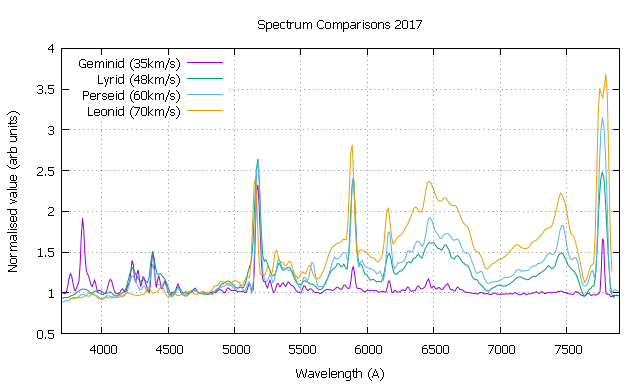- This topic has 5 replies, 3 voices, and was last updated 7 years, 10 months ago by
 Robin Leadbeater.
Robin Leadbeater.
-
AuthorPosts
-
25 January 2018 at 12:09 pm #573927
 Bill WardParticipant
Bill WardParticipantHi,
A years observing reduced to 4 squigly lines….

These spectra have not been instrument corrected to deliberately show some interesting effects.
The atmospheric emissions increase beautifully as the geocentric velocity increases. The broad bands running from 5550 to 7520A are in fact extremely complex emissions from N2. The Leonids carry four times the kinetic energy compared to the Geminds for the same given mass.
However the REALLY interetsing thing is at the other end of the spectrum. I chose these meteors because they were all of comparable magnitude and had similar spectrum coverage. At the blue end it is the slow, low KE Geminids that have the most emission (the purple line). To me this is highly counter intuitive, I could be wrong but if an object is experiencing more heating I would have thought that the same elements would have emitted more light.
So it could be related to the compositon, the three faster meteorids are cometary in origin, the slower Geminid is asteroidal in origin. It could be a coincidental vignetting effect but all of the spectra were in different positions with the fov so perhaps thats a bit unlikely. Or it could be some strange quantum emission effect, possibly self absorbtion. There must be some explanation as I have other spectra of Perseids and Leonids showing bright Mg, Ca+ and Fe lines in the deep blue and near UV! Some unusual convergence of physical properties combined with velocity….
There is lots of work about individual streams but I’ve never come across a multi-plot comparing spectra from different streams in a simple way like this, still things to learn and that’s pretty cool.
cheers,
Bill.
Attachments:
28 January 2018 at 8:52 am #579004 Steve BosleyParticipant
Steve BosleyParticipantFascinating comparison, Bill. Very clearly shows the effect of increasing KE. Will ask my spectroscopy expert for his opinion on the bit below 4000A.
Steve.
28 January 2018 at 5:23 pm #579007 Robin LeadbeaterParticipant
Robin LeadbeaterParticipantHi Bill,
These appear to be relative to a “continuum” equal to 1 are they normalised relative to some measured continuum or has the continuum just been applied to the uncorrected emission spectra as an offset ?
Robin
29 January 2018 at 1:38 pm #579011 Bill WardParticipant
Bill WardParticipantHi,
The emissions below 4000A are well know (Fe, Mg and Ca+, running left to right in the spectra). The point is that they are only seen (in this sample) in the Geminid and not the others. When fully calibrated and instrument corrected the Mg peak is the strongest in the entire spectrum. This “line” is actually an unresolved triplet centred around 3833A.
Bill.
29 January 2018 at 1:43 pm #579012 Bill WardParticipant
Bill WardParticipantHi,
Nothing has been done with any continuum as such. The graphs were normalised to each other around 4700A where there were few lines so a simple comparison could be made. When full corrections are done, the differences are still there but a lot more subtle. “For exposition only”, I think is the correct expression!
cheers,
Bill.
29 January 2018 at 2:56 pm #579013 Robin LeadbeaterParticipant
Robin LeadbeaterParticipantThanks Bill,
The reason I asked was that I was surprised to see that for the Geminid for example, the continuum has the same value across the wavelength range, given that it would be expected to be the product of the typical instrument response and the presumably black body curve of the thermal contribution to the spectrum. This continuum would also be expected to vary in shape for the different speed meteors depending on the temperature.
An alternative approach would be to plot the flux calibrated spectra with the continuum component subtracted which should show the relative intensity of the emission lines directly
Cheers
Robin
Robin
-
AuthorPosts
- You must be logged in to reply to this topic.
